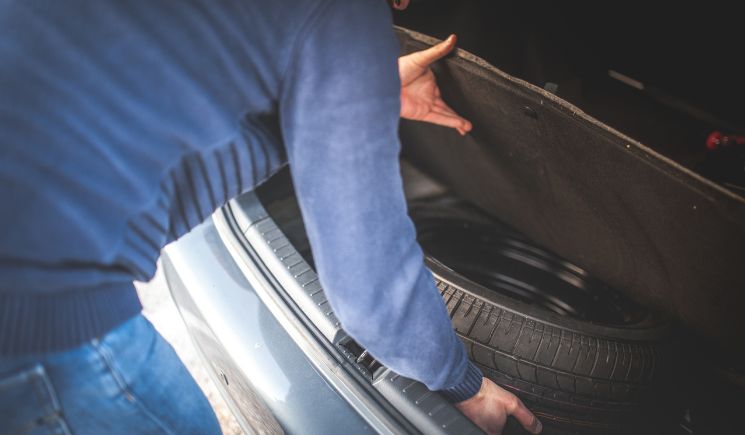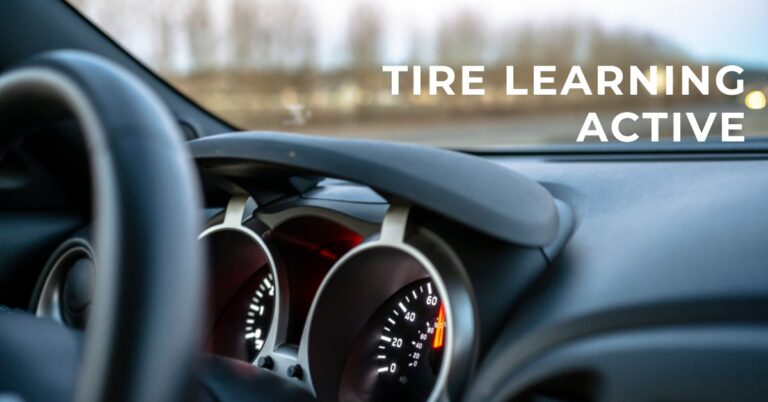Why Is My Tire Pressure Light Blinking When My Tires Are Fine

If your tire pressure light is blinking, it can be a worrying sight. This issue is one that many drivers face and the answer isn’t always clear-cut.
As an automotive technician, I’m here to explain why this problem may be occurring and how you can best address it.
In most cases, if the tire pressure light blinks when your tires are seemingly fine, it’s likely due to something called ‘sensor sensitivity’. Sensor sensitivity occurs when there is a minor discrepancy between the air pressure in each of your tires – such as being just 1 or 2 pounds off from what it should be.
It’s important to note that this usually doesn’t indicate any sort of major underlying issue with your vehicle; rather, it simply means that slight adjustment needs to be made.
Table of Contents
- What Causes A Tire Pressure Light To Blink?
- How To Check Tire Pressure
- How To Reset A Tire Pressure Light
- Troubleshooting Other Issues
- Ensuring Vehicle Safety And Efficiency
- Frequently Asked Questions
- Conclusion
What Causes A Tire Pressure Light To Blink?
A tire pressure light blinking is not something to take lightly. It can indicate any number of problems, from a simple leak in the tire or a more severe issue like an improperly mounted wheel. In either case, it’s important to get it checked out and fixed as soon as possible before further damage occurs.
The most common cause for a tire pressure light to blink is a fault with one or more tires. This could be caused by low air pressure, an unevenly worn tread, or even improper installation.
If the light stays on after checking all four tires and re-inflating them if necessary, then there may be another underlying problem at play – such as faulty wiring, corrosion within the system, or a malfunctioning computer module.
In order to ensure your safety while on the road, you should always know what condition your tires are in and how much air they have in them. Checking the pressure periodically is key to making sure that everything is running smoothly and safely. Moving forward into the next section we’ll discuss how best to check your tire pressure.
How To Check Tire Pressure
Ah, the tire pressure light. You see it blinking and immediately your heart sinks faster than a punctured tire. But don’t worry folks! We techs have seen this one before. It’s time to put on our detective caps and figure out what is going wrong with that pesky little warning lamp.
First thing’s first: check the tires for any obvious signs of damage or deflation. Visual inspection should be enough to tell if you’ve got a flat.
Next up, grab yourself a reliable air-pressure gauge and take all four tires for a spin around the block – err reading that is! Here are some tips for accurate readings:
- Make sure the tires are cold (not recently driven) when taking measurements
- Check each individual tire against its recommended pressure level
- Always compare left/right side pressures as well
Finally, if all else fails and nothing appears amiss in terms of physical wear or air-pressure levels, then there may be an issue with either your car’s computer system or TPMS sensors themselves. Time to call in the big guns – uhm I mean schedule an appointment with your local auto shop – so they can get you back on track safely and quickly.
How To Reset A Tire Pressure Light
Step 1: Check tire pressure Before attempting to reset the tire pressure light, ensure that all four tires are inflated to the recommended PSI (pounds per square inch) levels. This information can be found in your vehicle’s owner’s manual or on a sticker inside the driver’s door jamb.
Step 2: Start the vehicle Turn on your car’s ignition, but do not start the engine. This will allow you to access the vehicle’s settings and diagnostic features.
Step 3: Determine the reset method Check your vehicle’s owner’s manual to find out if the tire pressure light can be reset from within the vehicle or if a diagnostic tool is required.
Step 4A: Reset from within the vehicle If your vehicle allows for resetting the tire pressure light from within the car, locate the appropriate button or control on the dashboard. Press and hold it for about 10 seconds until a message appears saying ‘reset complete’. You may need to refer to your owner’s manual for specific instructions regarding your make and model.
Step 4B: Reset using a diagnostic tool If your vehicle requires a diagnostic tool to reset the tire pressure light, locate the OBDII port underneath your steering wheel. Connect the diagnostic tool and follow the specific manufacturer’s guidelines for resetting the tire pressure light. These instructions may be included with the tool or available online.
Step 5: Restart the ignition Turn off the ignition and then turn it back on to ensure the warning light has been cleared. If the tire pressure light remains on, double-check that all tires are inflated to the correct PSI and that there are no other issues with the tire pressure monitoring system.
Step 6: Inspect tires After successfully resetting the tire pressure light, inspect each tire for damage, wear, or other potential issues. Address any problems to ensure safe driving and proper tire function.
By following these steps, you should be able to reset your tire pressure light and address any underlying tire issues. If the light persists or other issues arise, consult a professional mechanic for assistance.
Troubleshooting Other Issues
In the United States, over 11 million vehicles are recalled each year due to safety or efficiency issues. As an automotive technician it’s important to be aware of these potential problems and have a plan for troubleshooting them.
When your tire pressure light is blinking but you know that the tires are fine, there may be other underlying issues that need to be addressed. The first step in this process is to check the air filter on your car—if it needs changing, replace it as soon as possible.
It’s also important to ensure all fluids are topped off and at the correct levels, such as engine oil and coolant. If any of these components are low or dirty, they can cause an issue with your tire pressure light.
Another crucial step is inspecting brakes and brake pads if necessary; worn out parts can cause your vehicle to malfunction in unexpected ways. Additionally, check whether something else is wrong with sensors or wiring related to your car’s tire pressure system.
If anything looks amiss after examining these items, take your car into a professional repair shop right away so they can determine what needs fixing and get you back on the road safely. Moving forward, ensuring vehicle safety and efficiency should be top priority while operating a motor vehicle.
Ensuring Vehicle Safety And Efficiency
Taking care of your vehicle’s tires is an essential part of ensuring its safety and efficiency. We’ll cover the basics below so you can identify any potential problems with your tire pressure light blinking.
First, it’s important to check the air pressure in all four tires on a regular basis. You should use a quality tire gauge that provides accurate reading within one or two pounds per square inch (PSI). If the readings are off by more than three PSI, then it’s time to fill up the tires with air accordingly.
Inspecting for signs of damage is also critical:
- Visual inspection: Look out for cracks, bulges or punctures in the sidewalls and treads.
- Sidewalls: Check for cuts and abrasions from road debris or curbs.
- Treads: Monitor wear patterns that may indicate improper alignment or overinflation/underinflation issues.
It’s also wise to rotate your tires every 6-7 months as recommended by most manufacturers to ensure even wear across each tire surface area.
Taking these steps will help prevent serious mechanical issues like poor gas mileage and steering instability due to misalignment caused by unevenly worn tires.
A quick checkup once a month will go a long way towards keeping your car running safely and efficiently.
Frequently Asked Questions
How Often Should I Check My Tire Pressure?
As an automotive technician, I always recommend checking tire pressure at least once a month.
It’s important to make sure the tires are properly inflated according to your vehicle manufacturer’s guidelines as this can help improve fuel efficiency and prolong the life of your tires.
You should also check your tire pressure when you’re driving long distances or during extreme temperatures – hot or cold – as this can cause fluctuations in air pressure.
What Type Of Tools Do I Need To Check My Tire Pressure?
To check your tire pressure, you’ll need a few basic tools.
First and foremost, you’ll need an accurate tire pressure gauge. This can be either a digital or analog model; both are equally reliable for this task.
You’ll also need a tire inflator to add air if necessary, as well as a valve stem cap to keep the air in.
Finally, make sure to have some soap and water on hand to clean off any dirt or debris from the valves before checking your tires’ pressure.
With all of these items at the ready, you should be able to accurately measure and adjust your tire pressure with ease.
What Is The Correct Tire Pressure For My Vehicle?
Checking tire pressure is an important part of maintaining your car’s performance and safety.
Every vehicle has a different ideal tire pressure, depending on its size, weight, and model year.
For example, the optimal pressure for a 2020 Honda Civic is 32 PSI in the front tires and 35 PSI in the rear tires.
As a technician, I recommend checking your owner’s manual or consulting with a mechanic to determine what the correct tire pressure should be for your specific make and model.
Keeping your tires at their recommended levels will ensure you have safe driving conditions and improved fuel efficiency.
What Should I Do If My Tire Pressure Is Too Low?
If your tire pressure is too low, the first thing you should do is add air until it’s at the correct level for your vehicle.
This can usually be found in your owner’s manual or on a sticker inside the driver side door panel.
Make sure to use an accurate tire pressure gauge so you don’t over-inflate and damage the tires.
Once that’s done, drive around for a bit and check again to make sure all four tires are inflated correctly.
If they’re still not right after two attempts, it may be time to take it into a qualified technician.
Are There Any Other Signs Of A Tire Pressure Problem That I Should Look Out For?
Your tires are like the eyes of your car, so it’s important to pay attention when they start to show signs of trouble.
When it comes to tire pressure problems, there are several things you should look for beyond just a blinking light.
You might notice that your vehicle is driving rougher than usual or that one side seems lower than the other.
Uneven wear on the tread can also be an indication that something isn’t quite right with your tires’ air pressure.
If you’re concerned, it’s best to have a professional automotive technician take a look and make sure everything is in order – better safe than sorry!
Conclusion
It’s important to check your tire pressure regularly in order to avoid any problems that could arise from low tires.
You should consult the owner’s manual for the correct pressure for your vehicle, and use a reliable tire gauge when checking.
If you find that one or more of your tires is too low, it’s best to fill them back up right away.
But if all your tires seem fine and yet your tire pressure light continues to blink – what then?
It may be time to have an automotive technician take a look at this issue as soon as possible so you can get back on the road safe and sound.
After all, why risk ignoring a potential problem with something as important as your car’s tires?






